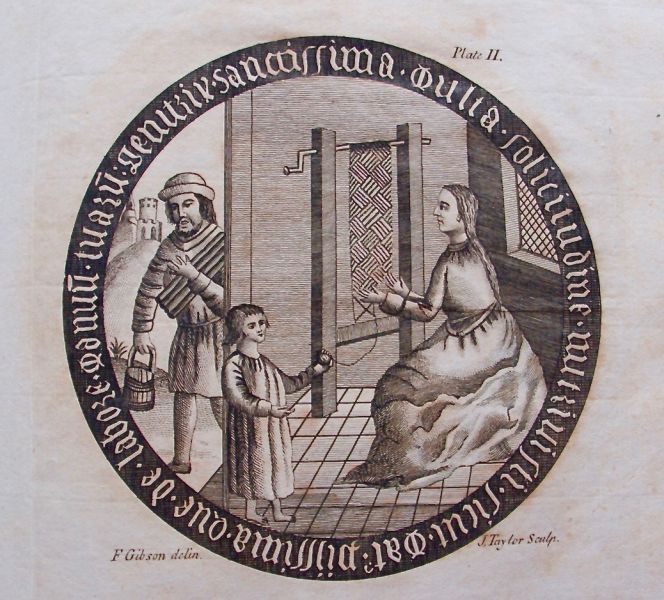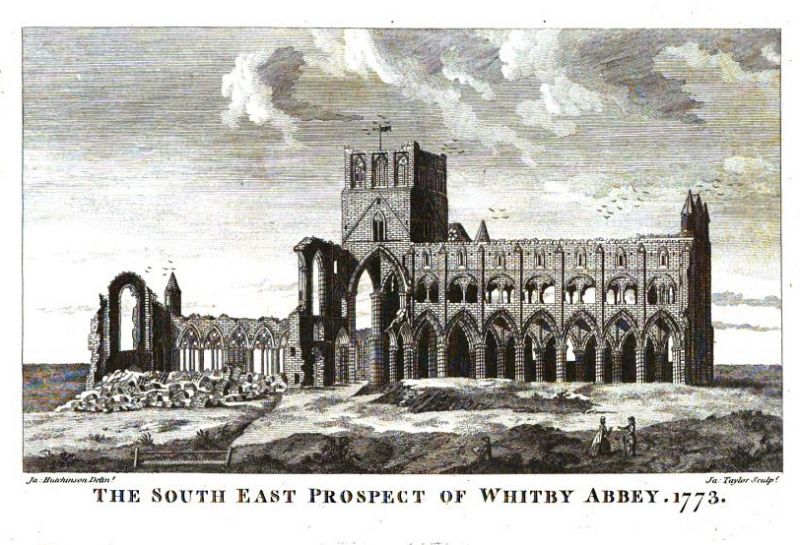ikfoundation.org
The IK Foundation
Promoting Natural & Cultural History
Since 1988


TWO TEXTILE REMNANTS
– from the Medieval Whitby Abbey
In the monograph The Textile History of Whitby 1700-1914, an introduction to earlier periods touched upon the long history of Whitby Abbey. This essay will give some further thoughts, studied via a preserved early 14th century embroidery that once was believed to have been part of the liturgical textiles of the abbey, and a book written by Lionel Charlton in the 1770s. The brief discussion will particularly focus on two men’s interest in the Medieval period – from an 18th century as well as a 1920s perspective – which gives us a glimpse of textile depictions in connection to the Medieval Whitby Abbey.
![The Embroidery in silk and silver-gilt thread is dated to circa 1310-1340 – and according to V&A’s records it is ‘Said to have come originally from Whitby Abbey’. Their source Mrs Archibald Christie additionally explained in the Burlington Magazine of 1921 (p. 9): ‘Formerly in the possession of the Cholmondley [Cholmley] family…’ (Courtesy of: V&A, no: T.344-1920).](https://www.ikfoundation.org/uploads/image/1-embroidery-whitby-abbey-800x765.jpg) The Embroidery in silk and silver-gilt thread is dated to circa 1310-1340 – and according to V&A’s records it is ‘Said to have come originally from Whitby Abbey’. Their source Mrs Archibald Christie additionally explained in the Burlington Magazine of 1921 (p. 9): ‘Formerly in the possession of the Cholmondley [Cholmley] family…’ (Courtesy of: V&A, no: T.344-1920).
The Embroidery in silk and silver-gilt thread is dated to circa 1310-1340 – and according to V&A’s records it is ‘Said to have come originally from Whitby Abbey’. Their source Mrs Archibald Christie additionally explained in the Burlington Magazine of 1921 (p. 9): ‘Formerly in the possession of the Cholmondley [Cholmley] family…’ (Courtesy of: V&A, no: T.344-1920).The museum (V&A) describes the well-preserved embroidery with a height of 24,5 cm and breadth of 25,5 cm as follows: ‘Square panel, probably from a burse, depicting the Crucifixion with the Virgin and St John enclosed within a barbed quatrefoil. Figures embroidered in silk in split stitch against a background of underside couched silver-gilt thread. Underdrawing is visible in worn areas, particularly Christ’s body. All four edges are unfinished. Unlined. Tiny rusted pinholes at each corner. Colours fresh on back.’ A “burse” is noted in the Oxford Dictionary as ‘a flat, square, fabric-covered case in which a folded corporal cloth is carried to and from an altar in church’.
The burse fabric was bequeathed by Robert Elliot Pannett to the Victoria and Albert Museum in 1920. Robert Elliott Pannett (1834-1920) was a Whitby solicitor who held various positions in local government during his professional life. He was also for many years deeply engaged with the Whitby Lit. & Phil. Society of which he became a member in 1861 before serving on the Committee from 1862 to 1920. Due to Pannett’s very long historical commitment to the local Whitby area and that the former owner – the Cholmley family – for several generations lived at Abbey House closely situated to the abbey, together with the facts assembled by the V&A and Mrs. A. Christie in 1921, give evidence for that this exquisitely made silk and silver-gilt embroidery most probably had its origin in the Medieval Whitby Abbey.
 This medieval glass panel with its centred loom was originally one of what must have been many glass windows in Whitby Abbey, that visitors at the abbey would have been able to study. It was described much later by Lionel Charlton in his 1779 book about the history of this reproduction. ‘These windows seem also to have been enriched with a considerable quantity of stained or painted glass. What was the fate of this is not certainly known, but it seems most probable to believe it was also carried away privately, as two panels thereof are yet remaining in the windows of a house belonging to Mr. Marmaduke Watson of Whitby, which are probably five or six hundred years old, and seem both to refer to the Virgin Mary…’ (Charlton, 1779, Plate II).
This medieval glass panel with its centred loom was originally one of what must have been many glass windows in Whitby Abbey, that visitors at the abbey would have been able to study. It was described much later by Lionel Charlton in his 1779 book about the history of this reproduction. ‘These windows seem also to have been enriched with a considerable quantity of stained or painted glass. What was the fate of this is not certainly known, but it seems most probable to believe it was also carried away privately, as two panels thereof are yet remaining in the windows of a house belonging to Mr. Marmaduke Watson of Whitby, which are probably five or six hundred years old, and seem both to refer to the Virgin Mary…’ (Charlton, 1779, Plate II).Hild’s Abbey and the Synod of Whitby were established already in 664 AD, and during the next two hundred years until 867 AD, a monastic settlement developed here. It was, however, not until around 1220 that the Gothic Abbey that survives as a ruin today was built; it served as an active monastic centre until it was abandoned following its forced dissolution in 1539.
 This detailed depiction of Whitby Abbey dating from 1773, introduced “Book Two” of Lionel Charlton’s publication. The image shows the contemporary reader a prospect of the disintegrated state of the Abbey, but also gives present day viewers a unique understanding of the building in the late 1700s which has today and since a long time been in ruins. Charlton’s comprehensive study of the Medieval Abbey and its history does on the other hand not reveal any more examples of its former textile treasures or everyday liturgical cloths/clothing. (Charlton, 1779, p. 48).
This detailed depiction of Whitby Abbey dating from 1773, introduced “Book Two” of Lionel Charlton’s publication. The image shows the contemporary reader a prospect of the disintegrated state of the Abbey, but also gives present day viewers a unique understanding of the building in the late 1700s which has today and since a long time been in ruins. Charlton’s comprehensive study of the Medieval Abbey and its history does on the other hand not reveal any more examples of its former textile treasures or everyday liturgical cloths/clothing. (Charlton, 1779, p. 48).Sources:
- Charlton, Lionel, The history of Whitby and of Whitby Abbey, York 1779.
- Hansen, Viveka, The Textile History of Whitby 1700-1914 – A lively coastal town between the North Sea and North York Moors, London & Whitby 2015 (pp. 9-13).
- Victoria and Albert Museum (V&A), London (Digital source: Medieval embroidery).
- Christie, Archibald, ‘A New Early English Embroidery at the Victoria and Albert Museum’, The Burlington Magazine, vol. 39, pp. 8-10, 1921.
More in Books & Art:
Essays
The iTEXTILIS is a division of The IK Workshop Society – a global and unique forum for all those interested in Natural & Cultural History from a textile Perspective.
Open Access essays, licensed under Creative Commons and freely accessible, by Textile historian Viveka Hansen, aim to integrate her current research, printed monographs, and earlier projects dating back to the late 1980s. Some essays feature rare archive material originally published in other languages, now available in English for the first time, revealing aspects of history that were previously little known outside northern European countries. Her work also explores various topics, including the textile trade, material culture, cloth manufacturing, fashion, natural dyeing, and the intriguing world of early travelling naturalists – such as the "Linnaean network" – viewed through a global historical lens.
For regular updates and to fully utilise iTEXTILIS' features, we recommend subscribing to our newsletter, iMESSENGER.
been copied to your clipboard




– a truly European organisation since 1988
Legal issues | Forget me | and much more...
You are welcome to use the information and knowledge from
The IK Workshop Society, as long as you follow a few simple rules.
LEARN MORE & I AGREE







